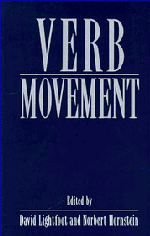Book contents
- Frontmatter
- Contents
- List of contributors
- Preface
- Verb movement: an introduction
- 1 Verb positions: evidence from Italian
- 2 Verb movement and word order in Arabic
- 3 Comments on the paper by Ouhalla
- 4 Some similarities and differences between Icelandic and Yiddish
- 5 Comments on the paper by Santorini
- 6 Finite verb movement in Scandinavian embedded clauses
- 7 Comments on the paper by Vikner
- 8 The Brythonic copula and head raising
- 9 A reinterpretation of evidence for verb movement in French
- 10 Two types of head movement in Romance
- 11 Comments on the paper by Roberts
- 12 Licensing heads
- 13 Comments on the paper by Koopman
- 14 Finiteness and head movement in early child grammars
- 15 Comments on the paper by Wexler
- References
- Index
14 - Finiteness and head movement in early child grammars
Published online by Cambridge University Press: 03 May 2011
- Frontmatter
- Contents
- List of contributors
- Preface
- Verb movement: an introduction
- 1 Verb positions: evidence from Italian
- 2 Verb movement and word order in Arabic
- 3 Comments on the paper by Ouhalla
- 4 Some similarities and differences between Icelandic and Yiddish
- 5 Comments on the paper by Santorini
- 6 Finite verb movement in Scandinavian embedded clauses
- 7 Comments on the paper by Vikner
- 8 The Brythonic copula and head raising
- 9 A reinterpretation of evidence for verb movement in French
- 10 Two types of head movement in Romance
- 11 Comments on the paper by Roberts
- 12 Licensing heads
- 13 Comments on the paper by Koopman
- 14 Finiteness and head movement in early child grammars
- 15 Comments on the paper by Wexler
- References
- Index
Summary
The problem of inflection
It has long been observed in the study of developmental linguistics that at an early age the child often omits verbal inflection or provides the “wrong” inflection (one that is wrong for the adult grammar that is developing). There are two traditional views concerning the explanation of this phenomenon. One view assumes that young children do not know about inflection and that they have to “learn” to “add” inflection. Knowledge of inflection is measured by the proportion of times that the inflection appears in obligatory contexts. This proportion increases over time, indicating greater knowledge. Possibly children learn to add inflection on a verb by verb basis. One variant of the view claims that at a young age even the verbs that a child produces with inflection are not truly inflected verbs. Rather they are unanalyzed “wholes.” On this view, the child does not understand the inflectional processes. Rather, inflection simply becomes stronger, as an associative element of a verb. We can call this the “Growing Strength” (GS) view.
An altogether opposite view is that the child does know the grammar of inflection. What she does not know are the forms of inflection. On this view the child knows not only the UG that underlies inflection, but also knows all the properties of the language that is developing except one set of properties—namely, the particular set of morphological forms that express the inflectional properties.
- Type
- Chapter
- Information
- Verb Movement , pp. 305 - 350Publisher: Cambridge University PressPrint publication year: 1994
- 213
- Cited by



